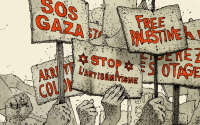9 May 2006
Humanity's Ground Zero
A Tomdispatch Interview With Mike Davis (Part 1)
His short hair and mustache are heavily flecked with grey, but he still retains the stocky, powerful build of a butcher's son, who once, long ago, hauled animal carcasses for his father in the San Diego suburb of El Cajon. At a moment's notice, he puts you in his four-wheel drive and takes you out to San Diego's McMansion exurbs or down to the Mexican border and right up to the new, controversial triple fence just being erected (where you have a passing run-in with the Border Patrol). He is the tour guide of your dreams, a walking encyclopedia of whatever is strange and riveting about Southern California. No object on the landscape seems to escape comment, brief description, or analysis. The bridge on the Interstate you drive across somewhere in the desert lands far out of town is the highest poured-concrete one in the country. The military vessels of every sort that crisscross San Diego's blue harbor are identified and discussed, including the stealth landing craft of the Navy SEALs. ("The Navy has more toys out here!")
A small lecture on the local real-estate market follows the complaint that "all anybody talks about these days in San Diego is real-estate values!" Each military base and reservation you pass is carefully pointed out. "People here don't notice the wall-to-wall military. They don't see the death all around them, the killing platforms. They just edit it all out." And every now and then, an odd memory from earlier days surfaces. ("The only good thing about growing up in San Diego was Navy-town and its cheap movie theaters. It was a teenage paradise.") Sitting shotgun in his car, you can't help but be aware that you are watching a dazzling -- if everyday -- performance from a polymath who seems never to have forgotten a thing.
His modest house is at the edge of one of San Diego's poorest neighborhoods which you get a brief spin through -- with a passing discussion of local graffiti thrown into the bargain. His small living room, where we set up my tape recorders, is dominated by a giant, multi-colored plastic playhouse for his two year-old twins, James and Cassandra (or Casey). To interview him in this house is to be surrounded by a world of revolutionary history. No wall, no nook or cranny, not even the bathroom, is lacking its revolutionary poster. ("Camarada! Trabaja y Lucha por la Revolution!") All around you feet threaten to stamp on Russian plutocrats, giant hands to smash the German exploiting class, while you are urged to "Vote Spartacus!" in 1919.
Mike Davis, whose first book about Los Angeles, City of Quartz, burst into bestsellerdom and put him on the map as this country's most innovative urban scholar, has since written about everything from the literary destruction of LA to Victorian holocausts of the 19th century and the potential avian flu pandemic of our own moment. He has most recently turned his restless, searching brain upon the global city in a new book, Planet of Slums, whose conclusions are so startling that I thought they should be the basis for our conversation.
We create a makeshift spot in the living room, my tape recorders between us, and begin. Davis has in him something of the older, nearly lost American tradition of the autodidact. In a tribal world, he would certainly have been any tribe's storyteller of choice. Midway through our interview, which is largely an inspired monologue, we are suddenly interrupted by weeping from elsewhere in the house. Casey has awoken from her nap upset. He quickly excuses himself, returning moments later with a collapsed, still sniffling, dark-haired little girl in pink pants and shirt on his shoulder. Under his ministrations she perks up, then sits up, then begins to talk, hardly less volubly (though slightly less comprehensibly) than her father. Soon she is seated inside the large plastic house, engaging both of us in a game of "big bad wolf." When she wanders off, perhaps twenty minutes later, he turns back to me and, before I can cue him on the interview (I've just checked his last words), he picks up in mid-sentence exactly where he left off and just rolls on.
Tomdispatch: I was hoping you would start by telling me how you came to the subject of the city.
Mike Davis: I came to the city by the most parochial path, which was studying Los Angeles, and I came to LA because, having been a Sixties new leftist and having invested a lot of time in studying Marxism, I thought radical social theory could explain just about anything. But it struck me that the supreme test would be understanding Los Angeles.
Maybe I shouldn't say this, but almost everything I've written about other cities has grown, at least in part, out of my LA project. For instance, investigating the tendency toward the militarization of urban space and the destruction of public space in Los Angeles has led me to explore similar trends as a global phenomenon. Interest in suburban Los Angeles got me considering the fate of older suburbs across the country and then the emergent politics of edge cities. So, in this consistently parochial way, the world emerged from Los Angeles which, in my original project, was a mosaic of about 450 individual pieces.
Let me explain: Back in the 1950s, when county welfare agencies were worried that war veterans moving into new suburbs had no sense of place, it did this big study of how many actual life-worlds there were in Greater Los Angeles and came to the conclusion that people lived in about 350 communities -- small towns, neighborhoods, suburbs. (Now, there are maybe 500 of these.) Behind my strategy for doing Los Angeles lay the thought that each of these constituent pieces had an entirely local, totally eccentric story to tell about itself, but also refracted some important aspect of the larger whole. I literally believe I could spend several lifetimes telling a story in each of these places about Los Angeles; so that was my methodology. I suppose in the process I only became an urbanist because people started calling me that. I've never actually considered myself a historian, sociologist, political economist, or urban theorist.
TD: So do you have a name for yourself?
Davis: Like some of the other survivors of the New Left, I thought of myself as an organizer, as doing power-structure or political analysis. Almost everything I've written or thought about corresponds in some insane way to what, in my mind at a given moment, seems to be the imperative from a strategic or tactical standpoint -- as if I were still answerable to the SDS National Council or the Chicago office of the IWW.
And this was all part of the strategic puzzle I addressed in City of Quartz. LA was at a critical cusp in its history. Globalization had reorganized its economy, rewiring it in dramatic ways, and many people were being left behind. Yet the city had -- and still has -- this incredible, protean potential for better things, for progressive politics, for surprising activism. At the time, I wanted to write a book that was usable by a new generation of activists, while trying to figure out how to look at a place like Los Angeles whose fantasy self has been embodied materially in its structure. It's a city that lives its images.
TD: And then the riots of 1992 burst out, no?
Davis: …and I tried to understand them as a direct consequence of the globalization process. Some people were victors, some losers. It was also a fact that globalization ultimately came to South-central LA in the form of the transnational drug industry. That was the only form of globalization which ever put any money on those streets. The successor volume to City of Quartz was to be a history of the Rodney King riots, told on a neighborhood by neighborhood basis -- the only narrative strategy that could possibly grasp the complexity of the events. Almost by accident, I had access to some of the key protagonists. I knew, for example, the mother of the guy who went to prison for almost killing the truck driver. I was also friends with the family of Dewayne Holmes, the principle instigator of the gang truce in Watts.
I hoped to weave these stories together with neighborhood histories to explain an uprising that was simultaneously a justifiable explosion of rage at the police, a postmodern bread riot, and a pogrom against Asian shop owners. But my ambition encountered crisis on two fronts. I could never find sufficient moral ground to loot people's lives for my narrative purposes or to assume the right to tell their stories. At the same time, I found the project too emotionally harrowing. The lives of my friends and acquaintances were filled with so much difficulty and pain, so much sadness and frustration. To live that with them -- and this was a time when I was working several jobs and about to become a single parent to a teenager -- this, I decided, was not what I could do. I had what I thought was an extraordinary design for a book in mind, but I couldn't find either the clear conscience or emotional stamina to write it.
Fortunately, natural disasters were added to my project -- and the riot book morphed into Ecology of Fear, a study of the fetishism of disaster in Southern California where the natural gets seen in social terms (with coyotes and mountain lions compared to street gangs), while social problems (like street gangs) are seen as natural events ("feral and wilding youth"). Ecology of Fear was about the inability of Anglo-American civilization ever to completely understand the metabolism of the actual Mediterranean world it lives in -- a misunderstanding that constitutes the very essence of Southern California.
In essence, I retreated to science and shifted from the micro-scale of biographies to the macro-scale of plate tectonics and El Nino. Science was my first love and I ended up writing that book largely in the geology library at Cal Tech rather than in the living rooms of people I knew in South and Central LA.
TD: If we jump 15 years to your newest book, Planet of Slums, with its vast urban canvas, can we imagine that you're now taking your marching orders from some global central committee? And can you launch us on the subject of our slumifying planet today?
Davis: Stunningly enough, classical social theory, whether Marx, Weber, or even Cold War modernization theory, none of it anticipated what's happened to the city over the last 30 or 40 years. None of it anticipated the emergence of a huge class, mainly of the young, who live in cities, have no formal connection with the world economy, and no chance of ever having such a connection. This informal working class isn't the lumpenproletariat of Karl Marx and it isn't the "slum of hope," as imagined 20 or 30 years ago, filled with people who will eventually climb into the formal economy. Dumped into the peripheries of cities, usually with little access to the traditional culture of those cities, this informal global working class represents an unprecedented development, unforeseen by theory.
TD: Just lay out some of the figures on the slumification of the planet.
Davis: Only in the last few years have we been able to see urbanization clearly on a global scale. Previously, the data was untrustworthy, but the United Nations Habitat has made heroic efforts involving new data bases, household surveys, and case studies to establish a reliable baseline for discussing our urban future. The report it issued three years ago, The Challenge of Slums, is as pathbreaking as the great explorations of urban poverty in the 19th century by Engels or Mayhew or Charles Booth or, in the United States, Jacob Riis.
By its conservative accounting, a billion people currently live in slums and more than a billion people are informal workers, struggling for survival. They range from street vendors to day laborers to nannies to prostitutes to people who sell their organs [for transplant]. These are staggering figures, even more so since our children and grandchildren will witness the final build-out of the human race. Sometime around 2050 or 2060, the human population will achieve its maximum growth, probably at around 10 to 10.5 billion people. Nothing as large as some of the earlier apocalyptic predictions, but fully 95% of this growth will occur in the cities of the south.
TD: In essence, in the slums…
Davis: The entire future growth of humanity will occur in cities, overwhelmingly in poor cities, and the majority of it in slums.
Classical urbanization via the Manchester/Chicago/Berlin/ Petersburg model is still occurring in China and a few other places. It's important to note, though, that the urban industrial revolution in China precludes similar ones in other places. It absorbs all the capacity for light manufacturing goods -- and increasingly everything else. But in China and a few adjacent economies, you still see city growth with an industrial motor. Everywhere else it's occurring largely without industrialization; even more shockingly, often without development in any sense. Moreover, what were, historically, the great industrial cities of the south -- Johannesburg, Sao Paulo, Mumbai, Bello Horizonte, Buenos Aires -- have all suffered massive deindustrialization in the last twenty years, absolute declines in manufacturing employment of 20-40%.
The mega-slums of today were largely created in the 1970s and 80s. Before 1960, the question was: Why were Third World cities growing so slowly? There were, in fact, huge institutional obstacles to fast urbanization then. Colonial empires still restricted entry to the city, while in China and other Stalinist countries, a domestic passport system controlled social rights and so internal migration. The big urban boom comes in the 1960s with decolonization. But then, at least, revolutionary nationalist states were claiming that the state could play an integral role in the provision of housing and infrastructure. In the 70s, the state begins to drop out, and with the 80s, the age of structural adjustment, you have the decade of going backwards in Latin America, and even more so in Africa. By then, you had sub-Saharan cities growing at faster velocities than Victorian industrial cities in their boom periods -- but shedding formal jobs at the same time.
How could cities sustain population growth without economic development in the textbook sense? Or, to put it differently, why didn't Third World cities explode in the face of these contradictions? Well, they did to some extent. At the end of the 80s and in the early 90s, you have anti-debt riots, IMF [International Monetary Fund] riots, all across the world.
TD: Are the '92 LA riots part of that?
Davis: Because Los Angeles combines features of a Third World as well as a First World city, it fits into the global pattern of unrest. What was invisible to LA's policymakers and leaders at the time, but obvious on the streets was the impact of the most severe recession since 1938 in Southern California -- from which the worst damage wasn't to the aerospace industry (though that was much written about at the time), but to the city's poor and immigrant neighborhoods. In a year -- where I lived downtown -- a vacant hillside populated by a handful of homeless, middle-aged black males suddenly had 100, 150 young Latinos camped out. They had been day laborers or dishwashers six months before.
If the detonating event was the Rodney King atrocity and the accumulated grievances of black youth in a community where global employment meant crack cocaine, it became a more complex, larger-scale event because of the widespread looting in Latino neighborhoods where people were hungry and living at the edge of homelessness.
TD: How did policymakers and leaders globally interpret what was happening in the cities?
Davis: The discovery by the World Bank, developmental economists, and big NGOs in the 1980s that, despite the almost total abdication of the role of the state in planning and providing housing for poor urban dwellers, people were still somehow finding shelter, squatting, surviving, led to the rise of a bootstrap school of urbanization. Give poor people the means and they'll build their own houses and organize their own neighborhoods. This was, in part, an entirely justifiable celebration of rank-and-file urbanism. But in the World Bank's hands, it became a whole new paradigm: The state is done; don't worry about the state; poor people can improvise the city. They just need some micro-loans…
TD: …And high-interest micro-loans at that.
Davis: Yes, that's right, and then poor people would miraculously create their own urban worlds, their own jobs.
Planet of Slums is intended to follow up the UN Challenge report, which alerted us that the global urban unemployment crisis was coequal to climate change as a threat to our collective future. Admittedly an armchair journey to cities of the poor, it is an attempt to synthesize a vast specialist literature on urban poverty and informal settlement. Two fundamental conclusions emerged.
First, the supply of free land for squatting had ended, in some cases a long time ago. The only way you can build a shack on free land now is to choose a place so hazardous that it will have no market value whatsoever. This increasing wager with disaster is what squatting has become. So, for instance, if I were to take you a few miles south and across the border to Tijuana you'd see almost immediately that land which once made up squatters' neighborhoods is now being sold, sometimes even subdivided and developed. Very poor people in Tijuana are squatting in the traditional fashion only at the edges of ravines and in streambeds where their houses will collapse in a couple of years. This is true all over the Third World.
Squatting has been privatized. In Latin America, it's called "pirate urbanization." Where, twenty years ago, people would have occupied vacant land, resisted eviction, and eventually been recognized by the state, they now pay high prices for small parcels of land or, if they can't afford it, rent from other poor people. In some slums, the majority of dwellers aren't squatters, they're renters. If you went to Soweto [in Johannesburg, South Africa], you'd see that people fill their backyards with shanties which they rent. The major survival strategy of millions of poor urban dwellers, who have been in the city long enough to have a little property, is to subdivide it and become landlords to yet poorer people, who sometimes subdivide and rent to others. So a fundamental safety valve, this much romanticized frontier of free urban land, has largely ended.
The other major conclusion concerns the informal economy -- the ability of poor people to improvise livelihoods through unrecorded economic activity like street vending, day labor, domestic service, or even subsistence crime. If anything, economic informality has been romanticized more than squatting, with vast claims about the ability of micro-entrepreneurship to leverage people out of poverty. Yet scores of case studies from around the world show ever more people squeezed into a limited number of survival niches: Too many rickshaw wallahs, too many street vendors, too many African women turning their shanties into shabeens to sell liquor, too many people taking in laundry, too many people queued up at work sites.
TD: In a way, aren't you saying that the former Third World is being turned into something like the Three Hundredth world?
Davis: What I'm saying is that the two principle mechanisms for accommodating the poor to cities in which the state long ago ceased to invest have reached their limits just when we're looking forward to two generations of continued high-speed growth in poor cities. The ominous but obvious question is: What lies beyond that frontier?
TD: Here's a quote from Planet of Slums: "With a literal great wall of high-tech border enforcement blocking large-scale migration to the rich countries, only the slum remains as a fully franchised solution to the problem of warehousing this century's surplus humanity."
Davis: The two major poor cities of 19th century Europe that fit our present model were Dublin and Naples, but nobody saw them as the future; and the reason there weren't more Dublins and Naples was, above all, the safety valve of the Atlantic emigration. Today, most of the south is, in fact, blocked from migrating. There's simply no precedent, for instance, for the kinds of borders Australia and Western Europe have constructed, essentially designed for total exclusion -- except for a limited flow of high-skill labor. The American border with Mexico has historically been of a different kind. It acts as a dam to regulate the supply of labor, not to close it off completely. But more generally, for people in poor countries today, there aren't the options poor Europeans had back then.
Inexorable forces are expelling people from the countryside and that population, made surplus by the globalized economy, piles up in the slums, on city peripheries that are neither countryside, nor really city, and that urban theorists have difficulty wrapping their minds around.
In the United States, we would call them exurbia, but exurbs here are quite a different phenomena. If you look at American cities, the most striking thing is that exurban settlement -- people who commute to edge cities from the former countryside are now living in McMansions on ever larger lots with more SUVs parked in front. They're making the traditional 50s Levittown suburb, with its ticky-tacky homes, its little cubicles of consumption, look environmentally efficient. In other words, as middle-class people move farther out, their environmental footprint goes up two or three shoe sizes.
The other side of this is the poorest people shoehorned into the most dangerous sites on tumbling hillsides, next to toxic waste dumps, living in flood plains, leading to every year's rising toll from natural disasters -- less a measure of changing nature than the desperate wagers poor people have to make. In the large cities of the Third World, you do have the flight of some of the rich to gated communities far out in the suburbs, but what you mainly have is two-thirds of the slum dwellers of the world piled up in a kind of urban no-man's land.
TD: You've called this "existential ground zero."
Davis: It is, because it's urbanization without urbanity. An example of this is the case of the radical Islamist group that attacked Casablanca a few years ago -- about 15 or 20 poor kids who grew up in the city but were in no sense part of it. They were born on the edge, not in traditional working-class and poor neighborhoods that support a fundamentalist Islam but not a nihilist one, or they were expelled from the countryside but never integrated into the city. In their slum worlds, the only kind of society or order was provided by mosques or Islamicist organizations.
According to one account, when these kids attacked the city, some of them had never been downtown before and this, for me, became a metaphor for what is happening across the world: a generation consigned to the urban dumping grounds, and not just in the poorest, most savage cities either.
Take Hyderabad, India's high-tech showcase, a city of 60,000 software workers and engineers where people duplicate the California lifestyle in Santa Clara Valley-like suburbs and you can go to Starbucks. Well, Hyderabad is surrounded by endless exterior slums, several million people. There are more rag pickers than software engineers. Some of these urban dwellers consigned to pick over the scraps of the high-tech economy had been expelled from more centrally located slums, torn down to make room for the research parks of the new middle class.






